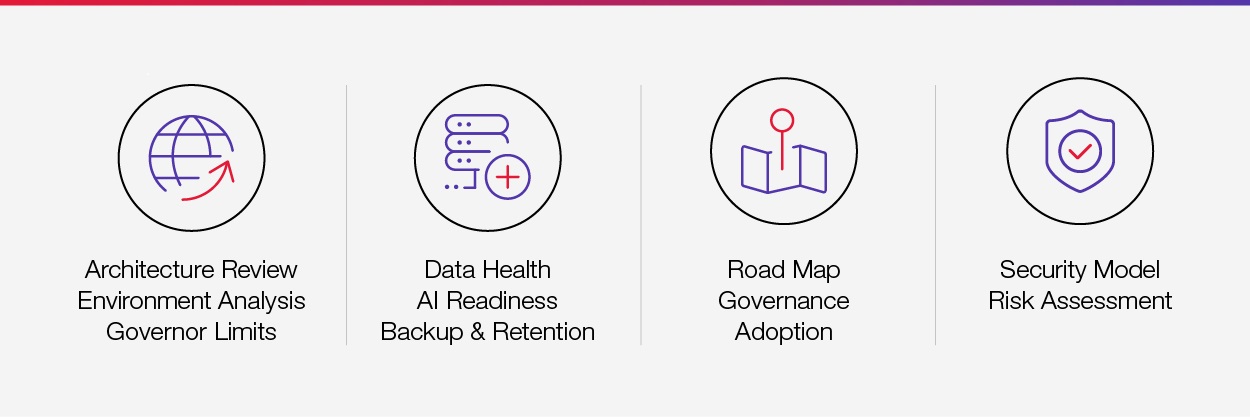Insights from CGI Salesforce architect Christina Smith
A common dilemma
Imagine this scenario: your organization bought Salesforce and has been using it for several years. You weren't part of the initial implementation or subsequent expansions, and, to make matters worse, a consulting firm provided a mere one-hour knowledge transfer session and handed over a daunting 75-page technical document to read. User complaints are piling up and stakeholders are frustrated because they're not seeing the expected value. New features and industry modules are announced by Salesforce that you suspect you may be able to use, but don’t know where to start.
Whether you inherited the system or simply feel overwhelmed by the challenge to continue innovating on the platform, fear not: We are revealing the mystery behind our Blueprint processes, which can help you take control of your Salesforce org and provide value to your stakeholders and development teams.
Blueprint: Your path to success
The CGI Salesforce Blueprint is a comprehensive analysis of your Salesforce program, designed to yield valuable insights within weeks. A Blueprint identifies risks and aligns your practices with industry best practices.
With Salesforce as the backbone of your organization - including businesses processes, governance, security, data and more, there is not one single type of assessment, but a plethora of options depending on your needs:
The Environment Blueprint is a thorough look "under the hood" of your Salesforce org. When conducting a review, focus on four key areas: Objects, Automation, Sharing & Visibility and Custom Code.
Several tools can assist in your review, including the Salesforce Optimizer, which is a native tool available to all Salesforce customers. (Note that the Salesforce Optimizer does not review managed packages).
Objects
The Object review serves as the bedrock for most customizations in your environment. During this analysis, pay close attention to your use of custom Objects and be mindful to avoid replicating standard Objects and functionality. We often see custom Objects created when a standard Object could have been customized with a Record Type, for example. Standard Objects will benefit from built-in features on the platform that you may have to replicate if designing a custom solution. Custom Objects will also require support and maintenance-dependent features like Page Layouts and Lightning Record pages.
When reviewing Objects, you’ll also want to look for unused fields, Record Types and Page Layouts. While keeping the metadata live in your system may not actively be harmful, it can be impactful to development teams during maintenance. Imagine the effort of rolling out a new field across 40 Page Layouts, when only three are used actively.
Automation
Automation can revolutionize the way your team operates, streamlining repetitive tasks and freeing up time for more strategic initiatives. Conduct an automation review to identify existing workflows, process builders and Flows in your org. Be sure to archive and deactivate anything that is not relevant to current business processes, as unused automation can slow system performance.
With Flow being an all-mighty and powerful automation tool, Salesforce is retiring Workflows and Process Builders. The Migrate to Flow tool will ease the transition in converting your existing automations, but it is a great opportunity to revisit your existing business processes and review where your automation may need updating or be combined for ease of maintenance.
Sharing & Visibility Model
Finding the right balance between accessibility and data security is critical for any Salesforce environment. A thorough sharing and visibility review will ensure that data is accessible to users who need it, while safeguarding sensitive information.
Leverage Salesforce's sharing rules, role hierarchies and profiles to fine-tune data access settings, down to the field level. We often see over-architected role hierarchies that resemble organizational hierarchies. It can be difficult to untether the structure, but consider that roles have a direct impact on system performance because record access is re-evaluated according to the sharing rules (the more numerous and complex they are, the slower your org will be).
Most importantly, make a schedule of regular audits to your sharing and visibility model, to accommodate organizational changes and comply with the latest data privacy regulations.
Custom Code Review
Custom code can be a double-edged sword. While it allows you to tailor Salesforce to your organization's unique needs, it also introduces potential risks and complexities.
Apex triggers should be designed carefully so that only one trigger fires per Object, per event. If this is not the case, the order of execution is nondeterminate and debugging becomes difficult. Apex code is compiled and executed against a specific version of the Apex API. Functionality and code behavior varies between API versions, for simplicity in debugging, so it is preferable that classes are all at the same (recent) API version.
Visualforce pages should be converted to Lightning Web Components, where possible. Salesforce best practice recommends that each Apex class should have a sibling test class responsible for testing the logic implemented within that class, to ensure that test classes are grouped with the logic that they test, keeping code manageable. While reviewing the custom code in your organization can be difficult and time-consuming, it will enable easier maintenance and improved user experience.
Blueprint for organizational success
Your Salesforce environment is not a single component of your technology stack; it's an enabler to your organization's success. Embrace the Blueprint assessment as an opportunity for growth, transformation, and continuous optimization. If you are considering a migration to an Industry Cloud, use it to drive insights to make informed development decisions, as well as to communicate with stakeholders.
While we reviewed the Blueprint in depth, consider additional evaluations such as an architectural review, data health and artificial intelligence (AI) readiness, security, data backup and retention, just to name a few.
Remember that this is an ongoing journey, not a one-time task. Through this proactive approach, you will not only address existing challenges but also anticipate future needs, helping your organization stay ahead of the curve.
As you embark on this path of discovery, do not hesitate to seek professional guidance. CGI has over 750 certified Salesforce professionals who can provide valuable insights, best practices and tailored solutions for your needs.
Learn more about CGI and Salesforce.






